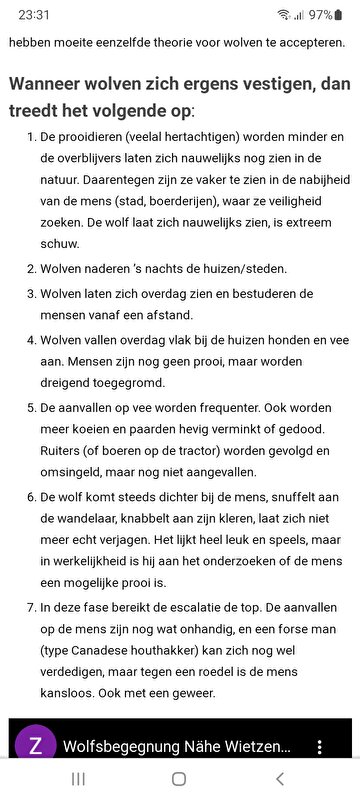Rizette schreef:Lees de escalatie stappen van Valerius Geist een wetenschapper en echte wolvendeskundige. We zitten hier in fase 6 de een na laatste fase voor de aanval op de mens.
Ik heb stap 3-6 er even bij gepakt.
Citaat:
3) The wolves appear in daylight and at some distance observe people doing their daily chores. Wolves excel at learning by close, steady observation. They approach buildings during daylight.
4) Small bodied livestock and pets are attacked close to buildings even during the day. The wolves act distinctly bolder in their actions. They preferentially pick on dogs and follow these right up to the verandas. People out with dogs find themselves defending their dogs against a wolf or several wolves. Such attacks are still hesitant and people save some dogs. At this stage wolves do not focus on humans, but attack pets and some livestock with determination. However, they may threaten humans with teethe exposed and growling when these are defending dogs, or show up close to a female dog in heat, or close to a kill or carryon defended by wolves. The wolves are still establishing territory.
5) The wolves explore large livestock, leading to docked tails, slit ears and hocks. Livestock may bolt through fences running for the safety of barns. The first seriously wounded cattle are found; they tend to have sever injuries to the udders, groin and sexual organs and need to be put down. The actions of wolves become more brazen and cattle or horses may be killed close to houses and barns where the cattle or horses were trying to find refuge. Wolves may follow riders and surround them. They may mount verandas and look into windows.
6) Wolves turn their attention to people and approach such closely, initially merely examining them closely for several minutes on end. This is a switch from establishing territory to targeting people as prey. The wolves may make hesitant, almost playful attacks biting and tearing clothing, nipping at limbs and torso. They withdraw when confronted. They defend kills by moving towards people and growling and barking at them from 10-20 paces away.
In stap 6 gaat om het gericht opzoeken van mensen. Wat er nu in Nederland gebeurd is dat de mens de wolf opzoekt, niet andersom. Als ik de stappen lees (en in mijn achterhoofd hou dat we in Nederland vee anders/intensiever/dichter op elkaar houden dan de gebieden waar hij vooral over schrijft(Noord Amerika, Rusland, Finland en dergelijken) dan zitten we eerder tussen 3 en 5 in. Wolven zoeken nog niet bewust overdag gebouwen op (stap 3), maar vallen wel al groot wild aan (stap 5), ondertussen vallen ze nog geen honden aan, maar hebben ze wel al territoria en eten ze klein vee, ook dichterbij gebouwen (allemaal stap 4).
Nu al zeggen dat we in stap 6 zitten lijkt mij overdreven.





 Zijn er ook paarden aangevallen die achter een wolfproof omheining stonden?
Zijn er ook paarden aangevallen die achter een wolfproof omheining stonden?